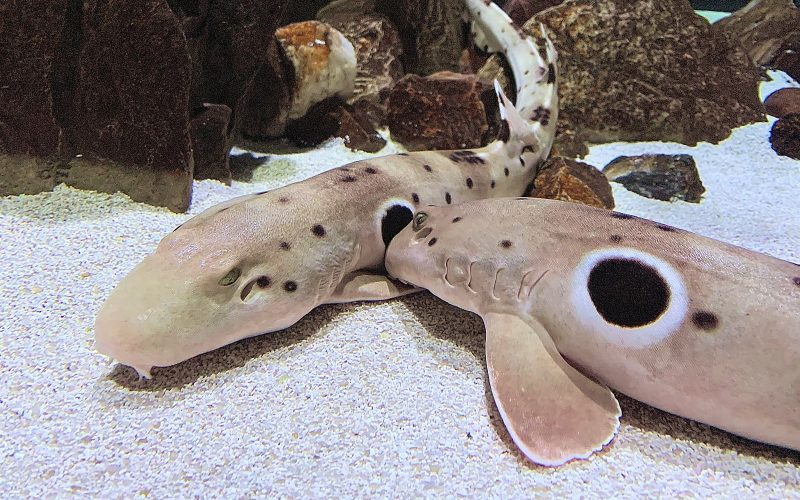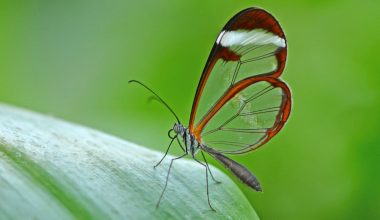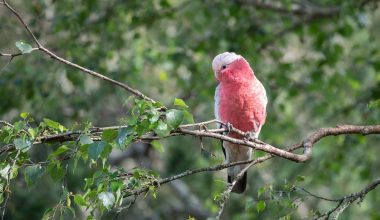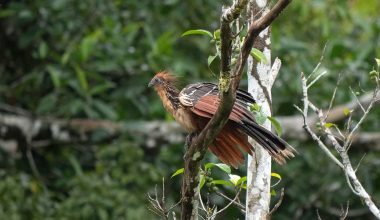Has your teacher ever brought up legs while discussing the anatomy of fish in class? Fish that can walk, perhaps? No, I stake. This is due to the fact that fish typically lack legs. Furthermore, it would be absurd to even consider fish with legs since, given that they spend their whole lives in water, why would they have legs? We will discuss 16 different types of fish with legs.
The enigmatic planet is full of wonders, though, and some fish species have legs and can move even outside of water to contradict that occurrence. However, this form of walking is more quadrupedal than bipedal, as is obvious. Since having legs would make swimming challenging for fish, it is difficult to envisage fish having legs. There is evidence that many aquatic creatures can, though. Mudfish, handfish, and Garnai are fish that have evolved to walk on the ground and have appendages resembling legs. Here is a list of 21 fish with legs.
Types of Fish With Legs
1. Red-lipped Batfish
One of the strangest sea species is the red-lipped batfish. It is an anglerfish, but unlike other species, it goes above and beyond with its peculiar characteristics. With its four thin pseudo legs, the red-lipped batfish adapts to its surroundings as a bottom-dweller. These legs enable the fish to wander and perch on sandy reefs on the ocean floor, enhancing its ability to feed. Intriguingly, the legs are better suited for walking than swimming (they have a clumsy swimming style). It is also listed as one of the animals with big lips in the world.
Red-lipped batfish can be seen at depths of between 3 to 76 m (10 to 249 ft) in the Pacific Ocean mostly around the Galapagos Islands and off Peru. There are no direct threats to the species, however, rising sea temperatures and coral bleaching could pose a threat to their survival. The mouth of the fish species is also unique and it seems they are having a red pout. Though the Red-lipped batfish are mostly seen at the depth b until you they are not good swimmers.
Also Read: Top 10 Ugliest Fishes In The World

Image Source: Vlad Karpinsky
2. Frogfish
The only limbless species you are likely to encounter is the frogfish. The Anglerfish family includes the Frogfish. To put it simply, these species have dorsal fins that function as limbs. The dorsal fin has grown to be larger and more adaptable than in other species, giving them the appearance of having limbs. This species is frequently encountered in tropical and continental aquatic settings. Little creatures have a lot of strength including frogfish. The small fish saunter around hunting for possible prey. Due to the peculiar limbs that surround their body, they are securely concealed.
Frogfish are known for their extremely flexible stomach that allows them to swallow prey up to twice their own size. If in any case, they attempt to swallow prey that exceeds their limits, they will forced to spit it out since it cannot be broken into smaller pieces. They can even mimic their surroundings in both form and color which makes them masters of camouflage. Frogfish has a size of 50cm, however, it will be very difficult to spot him since it has the same color and has the same appearance as the sponge corals that are growing beside it. They can even change color to match the environment.
Also Read: 10 Different Types of Fish with Big Foreheads
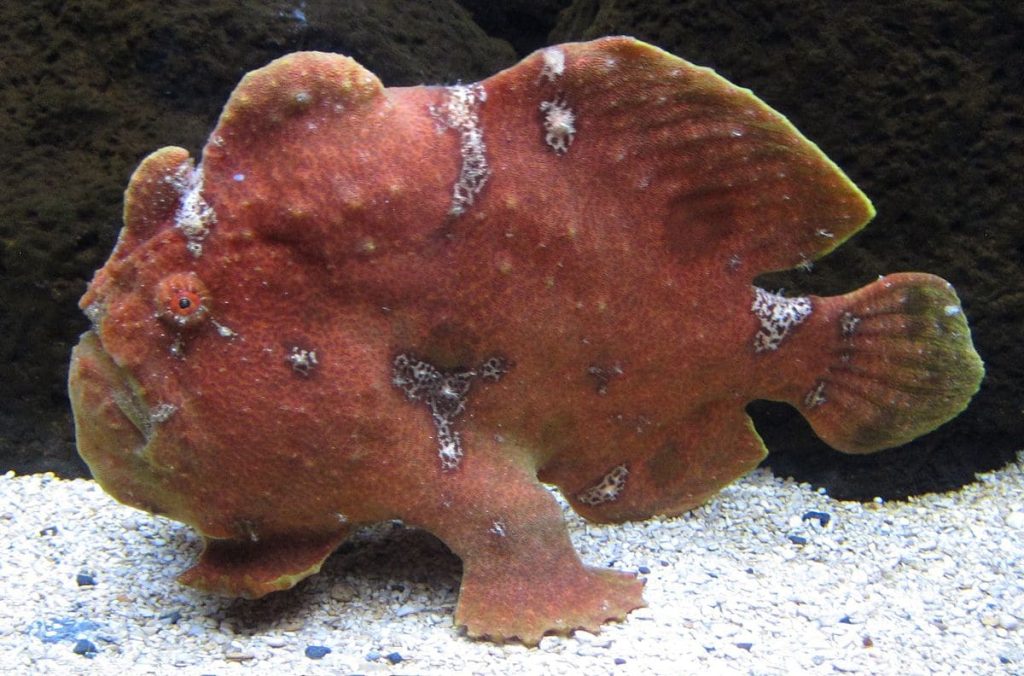
Image Source: Wikimedia
3. Mudskippers
At least 25 species of tiny tropical fish in the Oxudercinae family go by the collective name “mudskipper.” They really enjoy exploring dirty rivers and wetlands. Although each species is distinct, fish generally have noteworthy blunt heads and distinctively large, moveable projecting eyes. Mudskippers are just as bizarre as Red-lipped batfish, if not more so. These bizarre-looking fish have a natural curiosity that drives them to seek out life on land. And what’s this? They are capable of doing it.
Mudskippers are one of the popular fish with legs that have specialized gills that allow them to absorb oxygen from the air while on land. These social fish species are mostly seen in small groups showing territorial behavior and engaging in courtship displays. The primary diet includes small invertebrates such as insects, worms, and crustaceans. During mating season, male species perform elaborate courtship displays to attract females. They are also of skilled burrowers and they can create complex tunnel systems within the muddy substrate for shelter and protection.
Also Read: A List Of Fishes With Big Lips

Image Source: Wikipedia
4. Batfish
Due to the fact that both batfish and frogfish have expanded dorsal fins that serve as limbs, they are very similar. These two species are both livings, breathing anglerfish. Due to their fins, batfish may move more freely on the ocean floor. Despite sharing many characteristics with frogfish, batfish are very different from them. About 60 different varieties of batfish exist.
They lack the physical prerequisites for swimming. However, they maneuver around the bottom using their fins. Researchers have noted that they are recognized to have off of the oddest appearances of any animal discovered in the ocean, with their flathead, slim physique, and walking actions.
Also Read: Top 10 Amazing Fish With Big Eyes
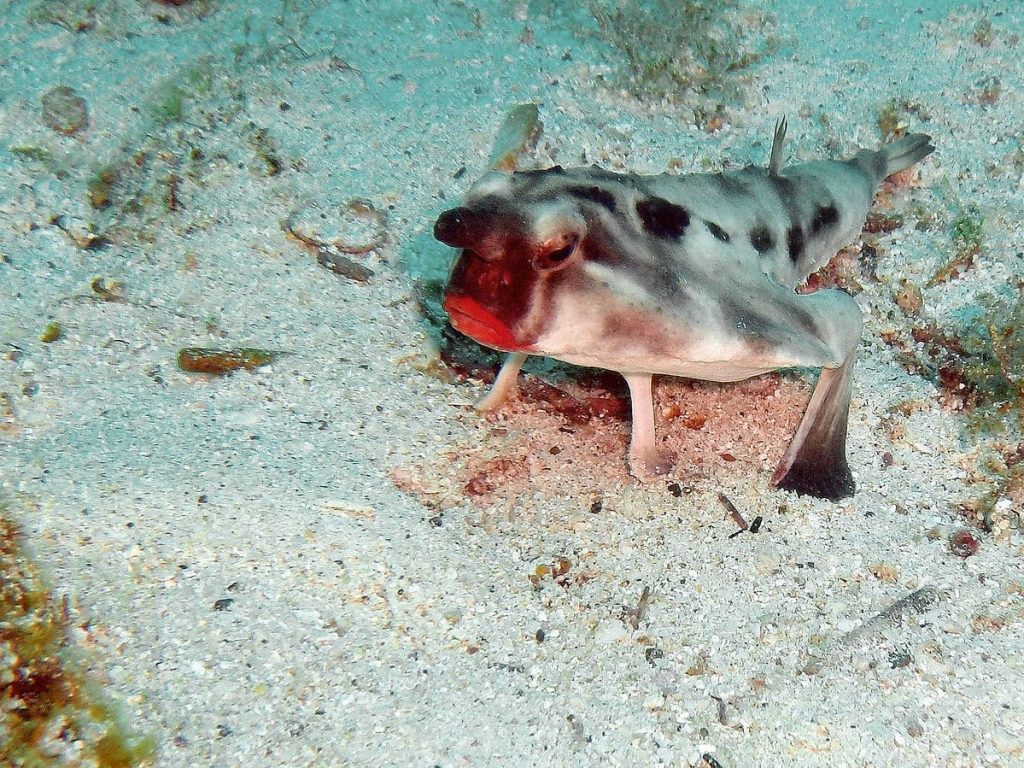
Image Source: Wikimedia
5. Tiktaalik Roseae
Even though the Tiktaalik roseae fish is extinct, we decided to include it because, when it was alive 375 million years ago, it showed signs of walking. As shown by fossil evidence, this enormous fish, which could reach lengths of up to three meters, possessed strong fins that served in a manner similar to tetrapod limbs. It was a fully aquatic creature that could be found swimming in the water but was also not afraid to stroll on mudflats and riverbanks.
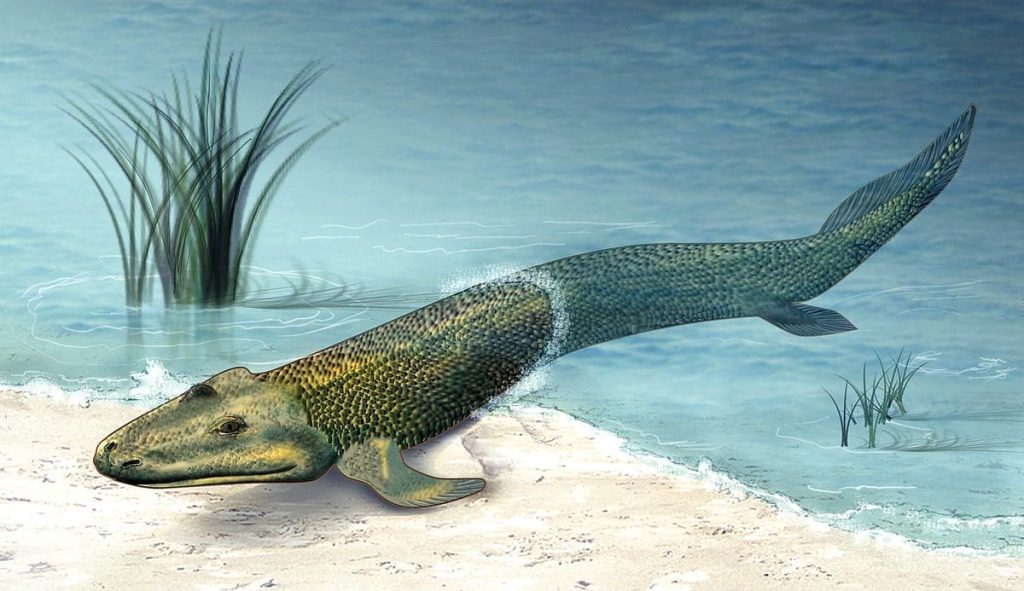
Image Source: Wikimedia
6. Handfish
Small and unusual fish known as handfish belong to the same anglerfish family as frogfish. Because they are poor swimmers, handfish, like their distant cousins, prefer to stroll rather than swim in the water. Additionally, although lacking legs, the tiny marine animals can easily travel across ocean floors because of the evolution of their pectoral fins, which have grown to resemble large hands. However, handfish lack lungs, just as mudskippers and lungfish, therefore they can only walk on water.
Handfish mostly seen in the waters of southern and eastern Australia and Tasmania. They can grow upto 15 cm (5.9 in) long, and have skin covered with denticles (tooth-like scales), giving them the alternate name warty anglers. They are one of the slow-moving fishes that prefer to ‘walk’ rather than swim with the help of their modified pectoral fins to move about on the sea floor. Similar to other anglerfish, they have an illicium, a modified dorsal fin ray above the mouth, however, they possess an illicium, a modified dorsal fin ray above the mouth.

Image Source: Wikimedia
7. Lungfish
A group of at least six fish species from the Protopteridae family is referred to as lungfish. They are among the oldest fish you can find. The fins of lungfish are a superb illustration of how fins turned into legs, claims Science Daily. For instance, the African lungfish inhabits swamps, wetlands, and freshwater rivers. However, they also have a few peculiar, fascinating adaptations that help them feel at home on dry land.
The lungfish can live on the ground because it can breathe oxygen, as suggested by its name, and hence one of the most amazing land and water animals in the world. It cannot, however, move on the ground. Due to evolution, these extraordinary animals have special gills and lungs that enable them to breathe oxygen and live below.
They appear to be moving along sea floors thanks to the distinctive fins on their bodies. If you were wondering where these strange fish come from, they have been around for a very long time. However, the archaeological data points to a Jurassic age for them. Scientists are inspired by these species’ lungs and ability to move on the ocean’s surface.
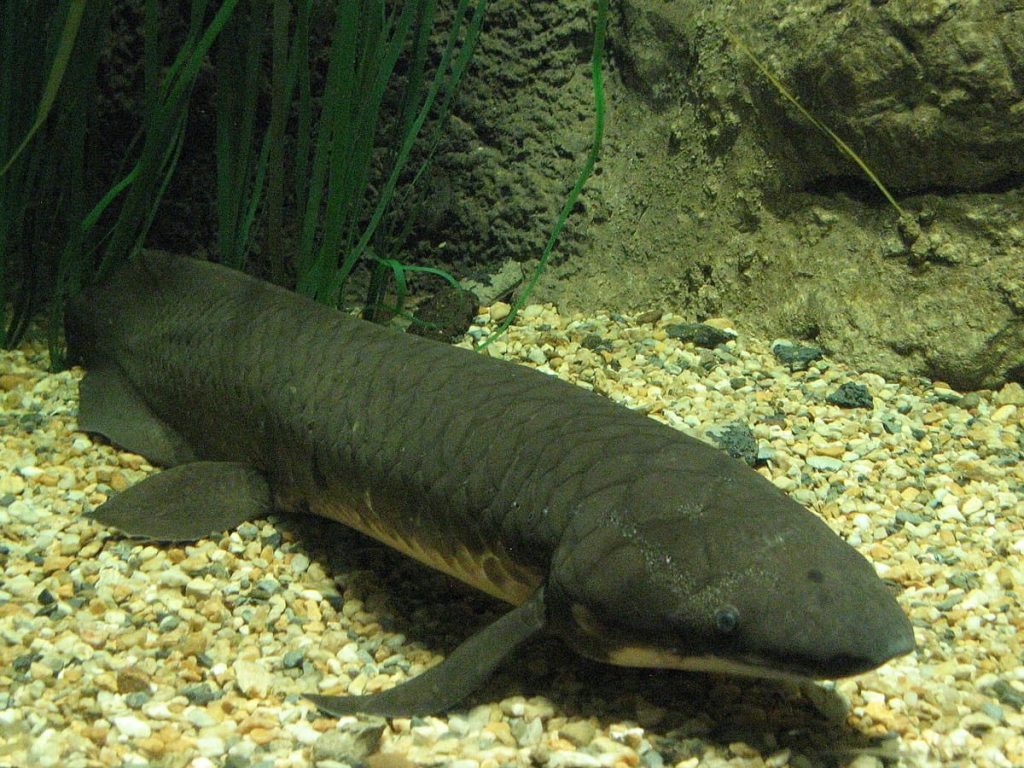
8. Polypterus Bichir
Polypterus bichir, often known as Nile bichir, is a huge polypterid fish with a flat head and cylindrical body. The fish that resembles an eel is so mysterious that even though it lacks legs and fins that resemble hands, it walks like a tetrapod. It employs pectoral fins that are placed tactically like lizard legs. The bichir lives in shallow waters of small rivers and ponds, where it only ventures ashore to stroll. The bichir has a set of lungs that allow it to breathe in the open air when it is near the water’s surface, despite the fact that it is unable to walk on land.
Polypterus Bichir also known as the Senegal bichir, gray bichir, or Cuvier’s bichir and even sometimes called “dinosaur eel” is a prototypical species of fish that belongs to the genus Polypterus. The fish species is native to Africa where they are the most widespread species of the genus. The breeding time of the fish species is during the rainy season in nature where the male chases and nudges the female. The female species used to lay between 100 to 300 eggs within a few days after the mating season. The primary diet includes small vertebrates, insects, and crustaceans.

Image Source: Wikimedia
9. Axolotl
These cutest animals in the world are contrary to popular belief, isn’t actually a fish. It is easy to confuse this species for one with limbs and a dorsal fin due to its incredibly prominent gills. The Mexican walking angler fish is the most common name for it. This strange little creature is actually a neotenic amphibian and one of the most popular freshwater animals in the world.
If you’re curious about what it alludes to, it’s a salamander that changes but keeps its lungs and stays in the sea. It’s a species of amphibious animal that has historically been connected to fish. Axolotls are commonly maintained as pets in aquariums despite being marine animals that can be found in a warm ocean.

Image Source: John P Clare
10. Coelacanth
Large, enigmatic, and living in the ocean’s depths, the coelacanth has a lifespan of about 100 years. The lateral fins of the extinct species, which extend from the limbs that resemble an abdomen, serve as a distinctive feature.
The species, which is thought to move deep inside the ocean, is said to use these coelacanth pseudolegs to walk back and forth in the water like a running calf. The way that vertebrate animals walk is comparable to that of humans. Unexpectedly, until 1938, when they discovered a number of healthy Coelacanths in South Africa, scientists believed the species was endangered.
Coelacanth were believed to be extinct until they were caught in 1938 when a live Latimeria chalumnae was discovered off the coast of South Africa. The fish species was important for understanding the transition from water to land since they are believed to be ancestors of tetrapods which is a four-legged land-living animal, however, recent analysis of the species shows that lungfish are actually more closely related to tetrapods. The striking feature of the coelacanth is its four fleshy fins that extend outside to the body and move in an alternating pattern.
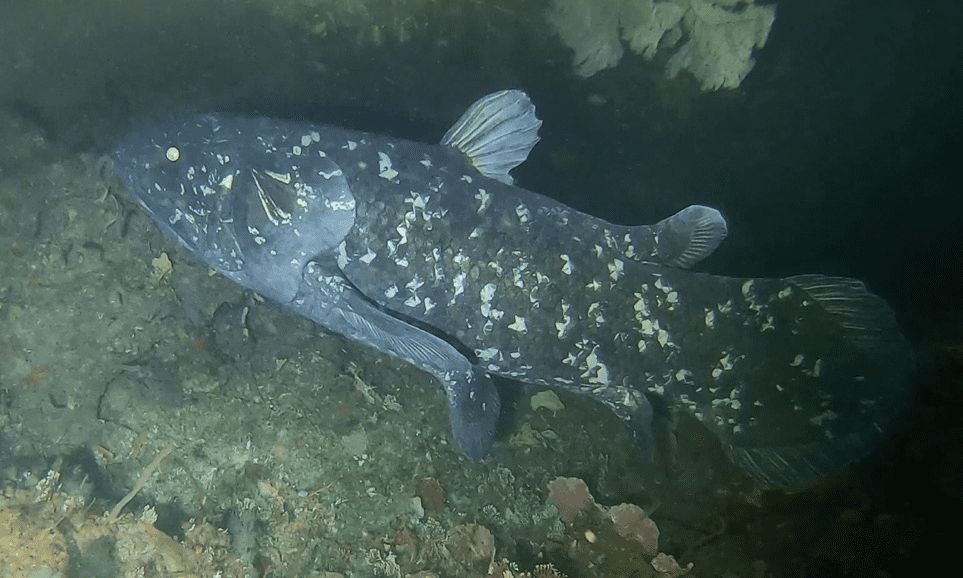
Image Source: Wikimedia
11. Warty Frogfish
The Warty frogfish is a marine fish that belongs to the family Antennariidae. The spices grow upto 15 cm (5.9 in) long and like other members of the family are known for their globulous and extensible bodies. It is also known as clown frogfish and has the capacity to change coloration and pigment patterns in a few weeks. This is known as coral bleaching events and they can even turn to plain white to blend in with the environment. They exhibit fluorescence, which means they are illuminated by blue or ultraviolet light and re-emit it as red, and appear differently than under white light illumination.

Image Source: Wikimedia
12. Snakehead fish
The Snakehead fish is a freshwater perciform fish that belongs to Channidae. The fish species is native to parts of Africa and Asia. The species have sacs above their gills that absorb and store oxygen from the air, allowing them to survive outside of water. Snakehead fish can also “walk” on land, moving their head and back fin in opposite directions to propel them forward. The dietary habits are carnivorous in nature and come with dagger-like teeth, making them dangerous predators.

Image Source: Wikimedia
13. Epaulette shark
The Epaulette shark is also referred to as The Walking Shark because it has the ability “walks” on its pectoral and caudal fins along the ocean floor and can also climb on rocks and even can walk on the surface. It belongs to the group of fish called the Elasmobranchii fish. The name of the fish has been derived from a large white-margined black spot behind each pectoral fin that is reminiscent of military epaulets. The fish species are mostly seen in the tropical waters off the coast of Australia and New Guinea.
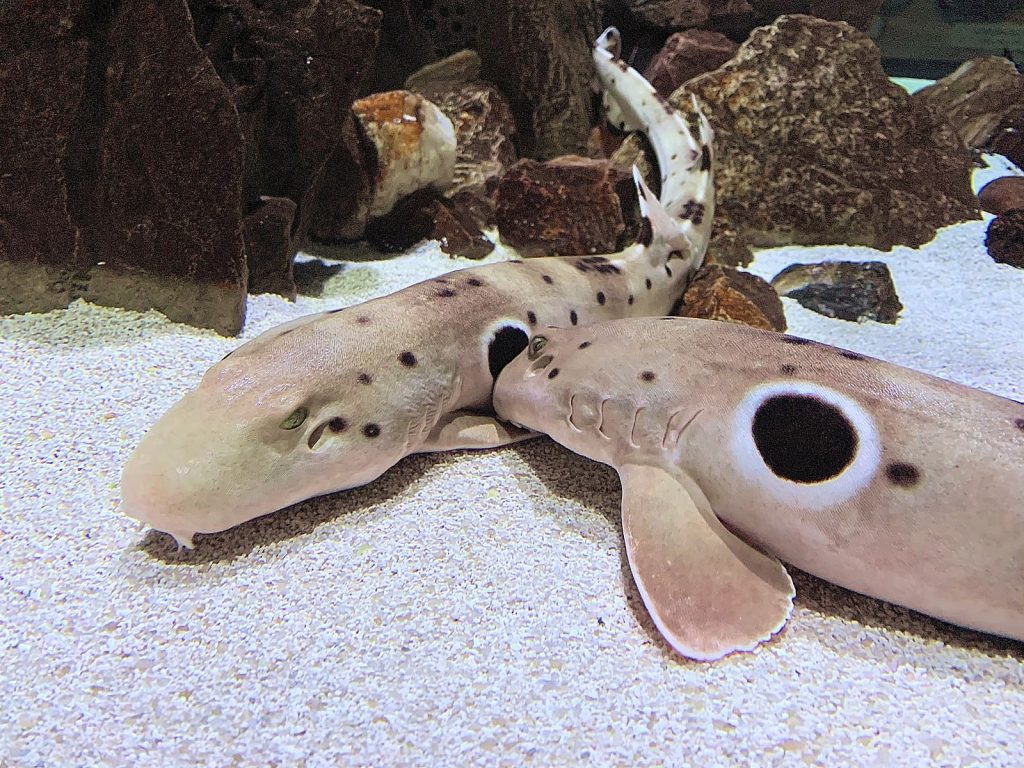
Image Source: Wikimedia
14. West African lungfish
The West African lungfish also known as Tana lungfish or simply African lungfish is a species of African lungfish. They are mostly seen in the freshwater habitats in West and Middle Africa, as well as the northern half of Southern Africa. The diet of the fish includes mollusks, crabs, prawns, and small fish within its distribution. The fish species has a prominent snout, small eyes, and a body that is long between 9 to 15 times the length of the head.
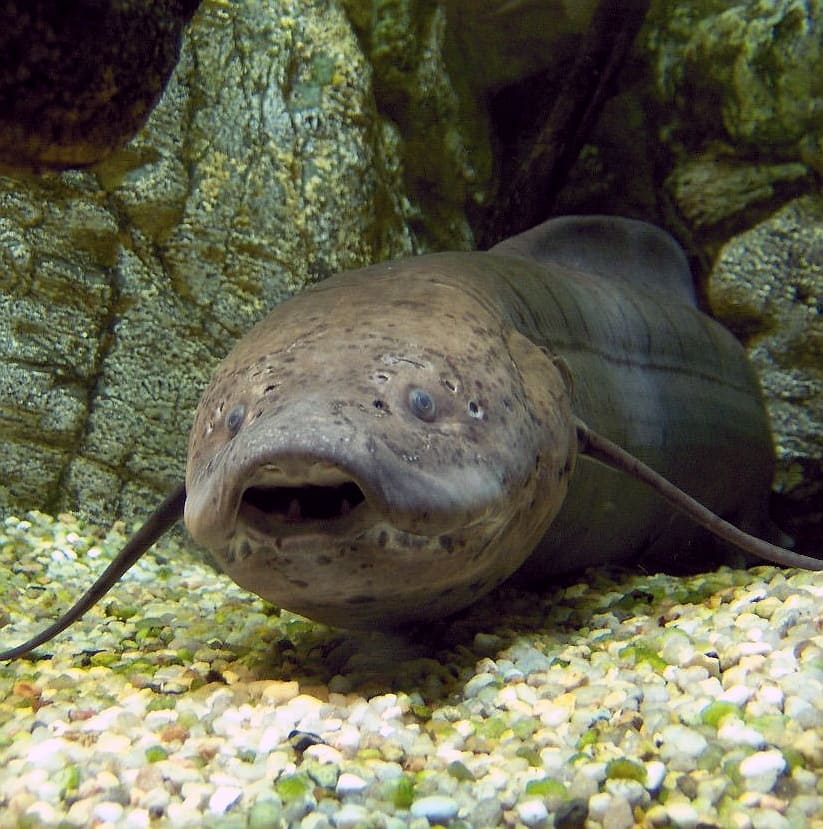
Image Source: Wikimedia
15. Sea Robin
Sea robins are a fish species that et thier name from fan-shaped pectoral fins which open and close rapidly when they swim, giving them a wing-like appearance. The primary diet includes crabs, worms, and fish. It can grow upto 45 cm in length and is mostly seen in sandy-bottomed, shallow waters from New England to North Carolina. They are capable of producing sound with the help of r swim bladders, similar to the oyster toadfish.
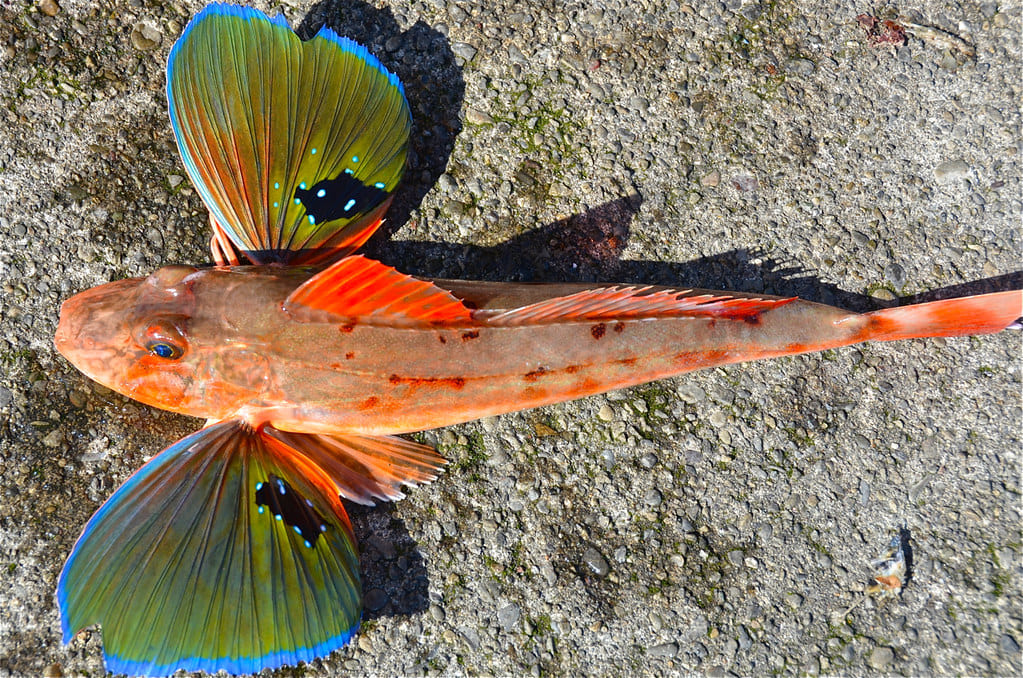
Image Source: Joejoe
16. Walking Catfish
The Walking Catfish is one of the fishes that are native to Southeast Asia. They are known for their ability to walk and wiggle across dry land, to find food or suitable environments, and hence listed as one of the fishes with legs. They use their pectoral fins to keep it upright as it makes a wiggling motion with snakelike movements to traverse the land. It prefers to swim in the stagnant waters in ponds, swamps, streams, and rivers, as well as in flooded rice paddies, or temporary pools that may dry up.
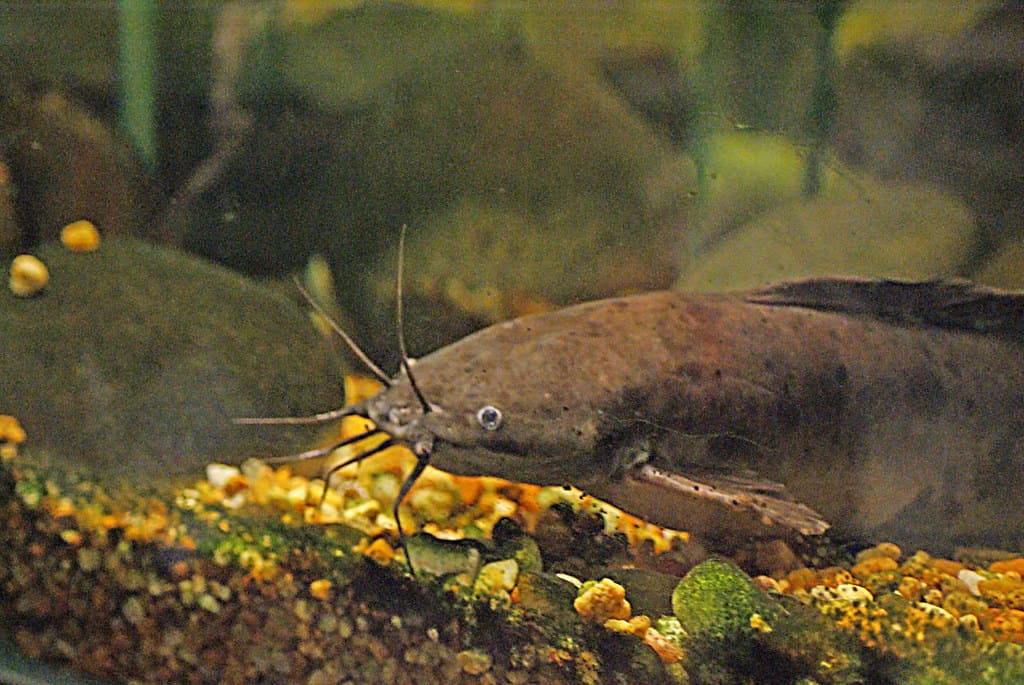
Image Source: Claradon
17. Hillstream Loaches
Hillstream Loaches, scientifically known as Sewellia lineolata, can grow up to 2.5 inches (6.4 cm), and the body has a streamlined shape, flat underside, and horizontal fins that can tightly grip onto any smooth surface. It was believed to have originated in the regions of Vietnam, Laos, and Cambodia. They prefer to thrive in riffles, river rapids, and slower-moving stream pools. The average lifespan of Hillstream Loaches is between 8 and 10 years in good care. It belongs to the Cobitoidea superfamily and the Cypriniformes order. The males will try to atrazine females with the help of a little mating dance, and if the female is interested, she will say yes by staying nearby him instead of going on about her business.
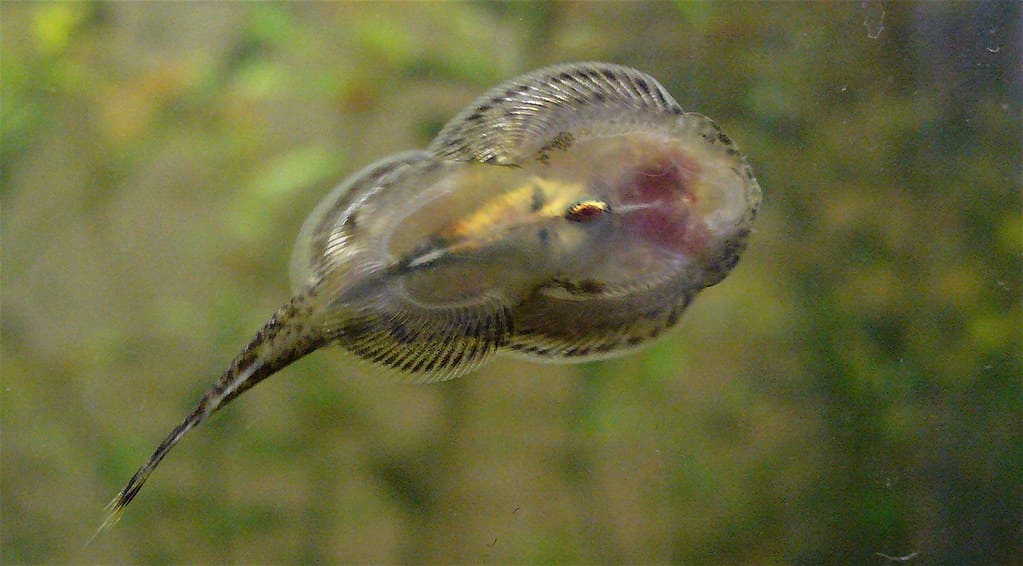
Image Source: Krista
18. Dinosaur Bichir
Dinosaur bichir, also known as Senegal bichir, grey bichir, or dragon fish, is among the ish with legs that belongs to the Polypteridae family. Talking about the appearance, it has long, cylindrical bodies that can grow up to one foot in length; however, it is grey or beige with subtle and splotchy patterning. The average lifespan of Dinosaur Bichir is between 10 and 15 years in good care. They have a variable coloration and come in grey, beige, or brown with an irregular pattern of large dark brown or black splotches. The optimal diet includes crustaceans, small fish, aquatic insects, and amphibians in the wild, and in captivity, it enjoys earthworms, shrimp, mussels, feeder fish, or dried pellets and flakes.
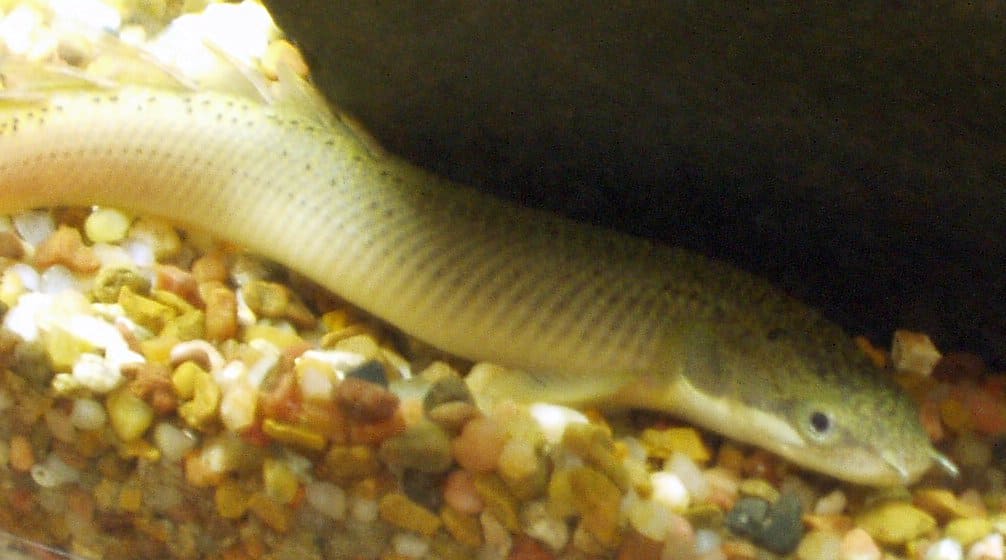
Image Source: Wikimedia
19. Polypterus lapradei
Polypterus bichir lapradei is a freshwater species that belongs to the Polypteridae. Talking about the appearance, the body of the species is elongated, subcylindrical, and covered in ganoid scales. The fish species was found by Napoleon Bonaparte, who was the leader of a campaign through Egypt in the years 1798–1801. When he came back to France, Saint-Hilaire described a very strange species of fish he collected in the Nile river in Egypt under the (vernacular) name of Polyptère bichir. After this, scientists all over the world became aware of a group of fish that was already extant 60 million years ago and had hardly changed shape since that time.

Image Source: lapradei
20. Tripod spiderfish
Tripod spiderfish, also known as tripod spiderfish, scientifically known as Bathypterois grallator, is a deep-sea fish that belongs to the family Ipnopidae. This is also refried, as the abyssal spiderfish has long, bony rays that stick out below its tail fin and both pelvic fins. The total length of a tripod spherfish is up to 43.4 cm (17.1 in) long, and its fins can be more than 1 m (3 ft 3 in). There were times when the fish species used to stand on these three fins at the bottom of the ocean, hunting for food. They are found relatively widely in the Atlantic, Pacific, and Indian oceans. The primary diet includes shrimp, tiny fish, and small crustaceans swimming by.
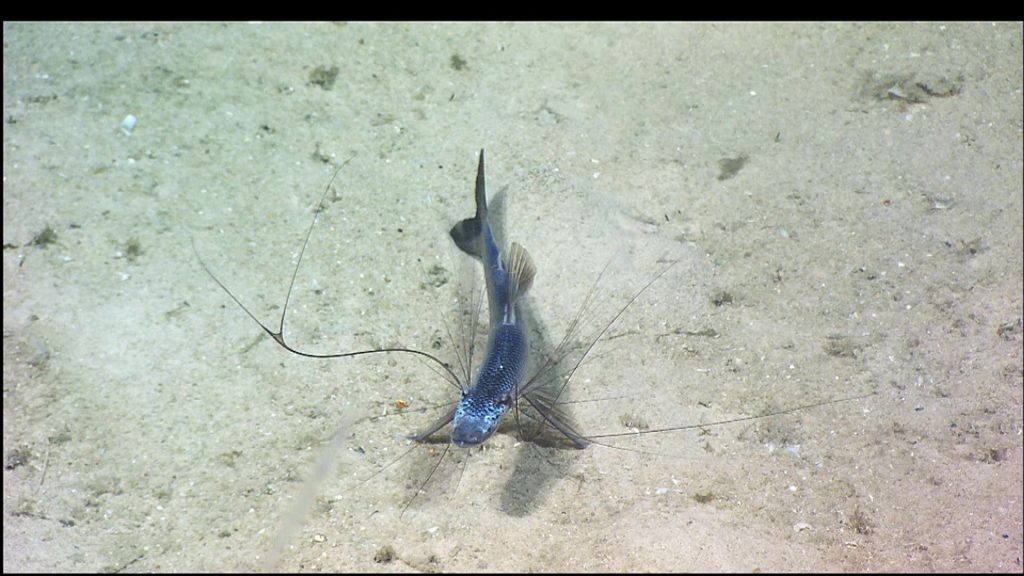
Image Source: NOAA photo library
21. Red Gurnard
Red gurnard, also known as East Atlantic red gurnard or soldier, is among the fish with legs that belong to the family Triglidae. They are found in the waters of the eastern Atlantic Ocean, including the Mediterranean Sea and the Black Sea. The fish species was formally described in 1758 as Trigla cuculus by Carl Linnaeus in the 10th edition of his Systema Naturae, with the type locality given as the Mediterranean Sea. Talking about the appearance, it has a large angular head that does not have a deep occipital groove but has a steep snout and is elongated forward with a flattened, two-lobed rostrum covered in denticles. The primary diet includes crabs, shrimp, small fish, and worms.

Image Source: Wikimedia
These are the 21 types of fish with legs. Kindly share and do post your comments.
